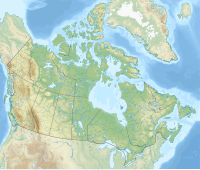Mont des Poilus
| Mont des Poilus | |
|---|---|
 Mont des Poilus seen from Yoho Valley | |
| Highest point | |
| Elevation | 3,161 m (10,371 ft)[1][2] |
| Prominence | 466 m (1,529 ft)[3] |
| Parent peak | Mount Baker (3180 m)[3] |
| Listing | Mountains of British Columbia |
| Coordinates | 51°35′41″N 116°36′24″W / 51.59472°N 116.60667°W[4] |
| Geography | |
| Country | Canada |
| Province | British Columbia |
| District | Kootenay Land District |
| Protected area | Yoho National Park |
| Parent range | Waputik Mountains Canadian Rockies |
| Topo map | NTS 82N10 Blaeberry River[4] |
| Geology | |
| Age of rock | Cambrian |
| Type of rock | sedimentary rock |
| Climbing | |
| First ascent | 1901 James Outram, Edward Whymper, guided by C. Kaufmann, C. Klucker and J. Pollinger[2] |
Mont des Poilus is a 3,161-metre (10,371-foot) mountain summit located in Yoho National Park, in the Canadian Rockies of British Columbia, Canada. Its nearest higher peak is Mount Baker, 8.0 km (5.0 mi) to the north.[3] Both are part of the Waputik Mountains.[3]
History
[edit]It was named by Arthur Wheeler one week following the armistice which ended World War I to honor the Poilu, the common soldiers of the French Army.[3]
The first ascent of Mont des Poilus was made 1901 by James Outram, Edward Whymper, guided by C. Kaufmann, C. Klucker and J. Pollinger.[3]
The mountain's name became official in 1924 when approved by the Geographical Names Board of Canada.[4]
Geology
[edit]Mont des Poilus is composed of sedimentary rock laid down during the Cambrian period. Formed in shallow seas, this sedimentary rock was pushed east and over the top of younger rock during the Laramide orogeny.[5] The Glacier des Poilus lies on the east aspect of the peak, and is part of the larger Waputik Icefield.[6]
Climate
[edit]Based on the Köppen climate classification, Mont des Poilus is located in a subarctic climate zone with cold, snowy winters, and mild summers.[7] Temperatures can drop below −20 °C with wind chill factors below −30 °C. Precipitation runoff from Mont des Poilus drains into the Yoho River and Amiskwi River, both tributaries of the Kicking Horse River.
See also
[edit]References
[edit]- ^ "Topographic map of Mont Des Poilus". opentopomap.org. Retrieved 2022-07-13.
- ^ Jump up to: a b "Mount Des Poilus". cdnrockiesdatabases.ca. Retrieved 2022-07-13.
- ^ Jump up to: a b c d e f "Mont des Poilus". Bivouac.com. Retrieved 2020-01-14.
- ^ Jump up to: a b c "Mont des Poilus". Geographical Names Data Base. Natural Resources Canada. Retrieved 2018-12-10.
- ^ Gadd, Ben (2008). Geology of the Rocky Mountains and Columbias.
- ^ "Glacier des Poilus". Geographical Names Data Base. Natural Resources Canada. Retrieved 2018-12-10.
- ^ Peel, M. C.; Finlayson, B. L.; McMahon, T. A. (2007). "Updated world map of the Köppen−Geiger climate classification". Hydrol. Earth Syst. Sci. 11: 1633–1644. ISSN 1027-5606.
External links
[edit]- "Mont des Poilus". BC Geographical Names.
- Parks Canada web site: Yoho National Park
- Mont des Poilus weather: Mountain Forecast
- Climbing Mont des Poilus: Explor8ion.com



